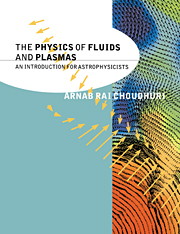Book contents
- Frontmatter
- Contents
- Preface
- Acknowledgements
- Introduction
- Part I Neutral fluids
- Part 2 Plasmas
- 10 Plasma orbit theory
- 11 Dynamics of many charged particles
- 12 Collisionless processes in plasmas
- 13 Collisional processes and the one-fluid model
- 14 Basic magnetohydrodynamics
- 15 Theory of magnetic topologies
- 16 Dynamo theory
- Epilogue
- Appendix A Useful vector relations
- Appendix B Integrals in kinetic theory
- Appendix C Formulae and equations in cylindrical and spherical coordinates
- Appendix D Values of various quantities
- Appendix E Basic parameters pertaining to plasmas
- Suggestions for further reading
- References
- Index
16 - Dynamo theory
from Part 2 - Plasmas
Published online by Cambridge University Press: 05 June 2012
- Frontmatter
- Contents
- Preface
- Acknowledgements
- Introduction
- Part I Neutral fluids
- Part 2 Plasmas
- 10 Plasma orbit theory
- 11 Dynamics of many charged particles
- 12 Collisionless processes in plasmas
- 13 Collisional processes and the one-fluid model
- 14 Basic magnetohydrodynamics
- 15 Theory of magnetic topologies
- 16 Dynamo theory
- Epilogue
- Appendix A Useful vector relations
- Appendix B Integrals in kinetic theory
- Appendix C Formulae and equations in cylindrical and spherical coordinates
- Appendix D Values of various quantities
- Appendix E Basic parameters pertaining to plasmas
- Suggestions for further reading
- References
- Index
Summary
Magnetic fields in the Cosmos
Around 1600 William Gilbert, physician to Queen Elizabeth I of England, proposed a bold hypothesis to explain why a suspended compass needle points in the north–south direction. He suggested that the whole Earth is a huge magnet and attracts the compass needle. This is probably the first time that somebody proposed an astronomical object—the planet Earth—to have a large-scale magnetic field. Initially it was thought that the Earth's magnetism was of ferromagnetic origin. By the end of the nineteenth century, it became clear that a ferromagnetic substance does not retain the magnetism when heated beyond a certain temperature (the Curie point). Since the interior of the Earth is believed to be hotter than the Curie temperature of any known ferromagnetic substance, it was apparent that one has to look for alternative explanations for the Earth's magnetic field.
Until the beginning of the twentieth century, it was not known whether other astronomical objects have magnetic fields as well. When Hale (1908) made the momentous discovery of magnetic fields in sunspots on the basis of the Zeeman splittings of sunspot spectra, the existence of magnetic fields outside the Earth's environment was conclusively established for the first time. Large sunspots can have magnetic fields of the order of 3000 G, which is much stronger than the Earth's field (the maximum value on the Earth's surface is about 0.6 G). One of the major achievements of twentieth century astronomy is to establish that magnetic fields are ubiquitous in the Universe.
- Type
- Chapter
- Information
- The Physics of Fluids and PlasmasAn Introduction for Astrophysicists, pp. 340 - 362Publisher: Cambridge University PressPrint publication year: 1998
- 1
- Cited by



